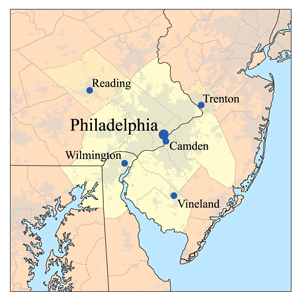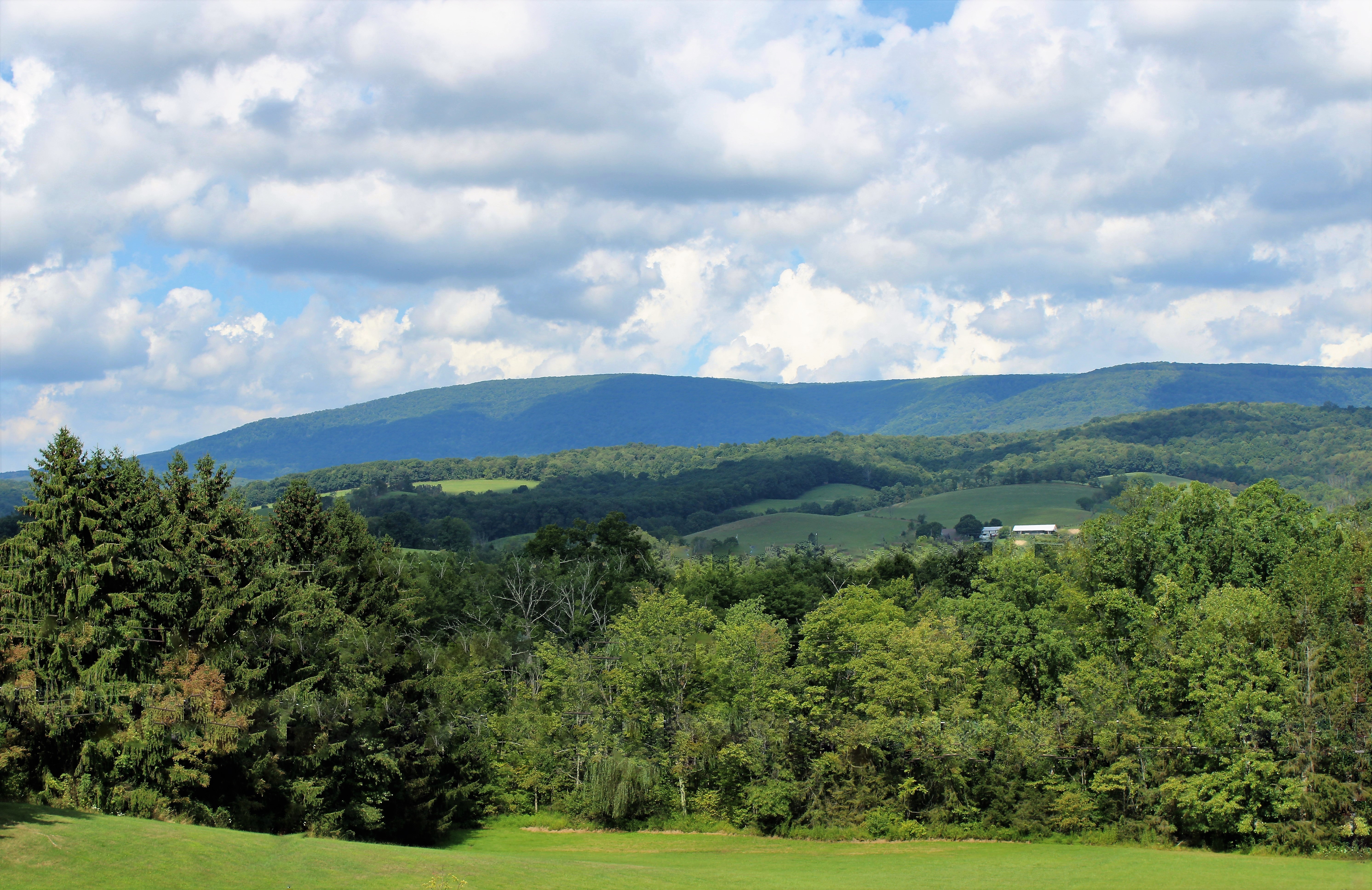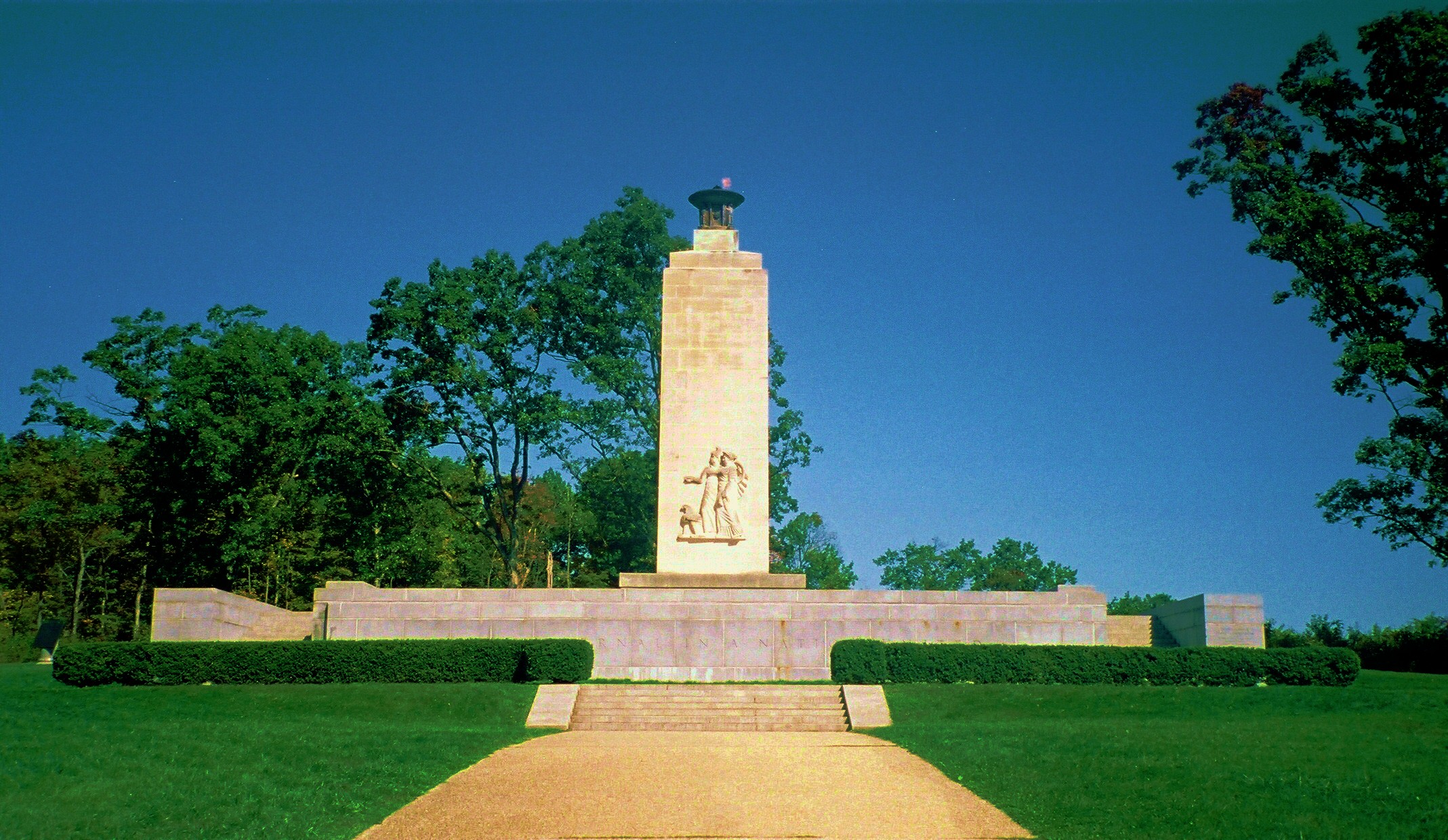|
1956 United States Presidential Election In Pennsylvania
The 1956 United States presidential election in Pennsylvania took place on November 6, 1956 as part of the 1956 United States presidential election. Voters chose 32 representatives, or electors to the Electoral College, who voted for president and vice president. Pennsylvania strongly voted for the Republican nominee, President Dwight D. Eisenhower, over the Democratic nominee, former Illinois Governor Adlai Stevenson. Pennsylvania was the home state of President Eisenhower, as he moved to the Gettysburg area after World War II. Eisenhower won Pennsylvania by a solid 13.19% margin, and carried every county except Philadelphia and four heavily unionized coal counties in the southwestern "Black Country". This result nonetheless made Pennsylvania 2.21% more Democratic than the nation-at-large. This was the last time Pennsylvania voted for a Republican presidential candidate until Eisenhower’s running mate, Richard Nixon, won the state in his re-election bid in 1972. Results ... [...More Info...] [...Related Items...] OR: [Wikipedia] [Google] [Baidu] |
Dwight D
Dwight may refer to: People * Dwight (given name) * Dwight D. Eisenhower (1890–1969), 34th president of the United States and former military officer *New England Dwight family of American educators, military and political leaders, and authors * Ed Dwight (born 1933), American test pilot, participated in astronaut training program * Mabel Dwight (1875–1955), American artist * Elton John (born Reginald Dwight in 1947), English singer, songwriter and musician Places Canada * Dwight, Ontario, village in the township of Lake of Bays, Ontario United States * Dwight (neighborhood), part of an historic district in New Haven, Connecticut * Dwight, Illinois, village in Livingston and Grundy counties * Dwight, Kansas, city in Morris County * Dwight, Michigan, an unincorporated community * Dwight, Nebraska, village in Butler County * Dwight, North Dakota, city in Richland County * Dwight Township, Livingston County, Illinois * Dwight Township, Michigan Institutions * Dwight Correctional ... [...More Info...] [...Related Items...] OR: [Wikipedia] [Google] [Baidu] |
1972 United States Presidential Election In Pennsylvania
The 1972 United States presidential election in Pennsylvania took place on November 7, 1972, and was part of the 1972 United States presidential election. Voters chose 27 representatives, or electors to the Electoral College, who voted for president and vice president. Pennsylvania strongly voted for the Republican nominee, President Richard Nixon, over the Democratic nominee, Senator George McGovern. Nixon won Pennsylvania by a large margin of 19.98%, winning every county except for Philadelphia. This result nonetheless was over 3% more Democratic than the nation at-large. , this is the last election in which Allegheny County voted Republican,Sullivan, Robert David‘How the Red and Blue Map Evolved Over the Past Century’ ''America Magazine'' in ''The National Catholic Review''; June 29, 2016 and the last time that county did not vote the same as Philadelphia. As of 2020, this marked the last time when the Republican presidential nominee carried the state by double digi ... [...More Info...] [...Related Items...] OR: [Wikipedia] [Google] [Baidu] |
Bucks County, Pennsylvania
Bucks County is a county in the Commonwealth of Pennsylvania. As of the 2020 census, the population was 646,538, making it the fourth-most populous county in Pennsylvania. Its county seat is Doylestown. The county is named after the English county of Buckinghamshire. Bucks County is part of the northern boundary of the Philadelphia– Camden– Wilmington, PA– NJ– DE– MD Metropolitan Statistical Area, more commonly known as the Delaware Valley. It is located immediately northeast of Philadelphia and forms part of the southern tip of the eastern state border with New Jersey. History Founding Bucks County is one of the three original counties created by colonial proprietor William Penn in 1682. Penn named the county after Buckinghamshire, the county in which he lived in England. He built a country estate, Pennsbury Manor, in Falls Township, Bucks County. Some places in Bucks County were named after locations in Buckinghamshire, including Buckingham and Buckingham T ... [...More Info...] [...Related Items...] OR: [Wikipedia] [Google] [Baidu] |
Bradford County, Pennsylvania
Bradford County is a county in the Commonwealth of Pennsylvania. It is part of Northeastern Pennsylvania. As of the 2020 census, its population was 59,967. Its county seat is Towanda. The county was created on February 21, 1810, from parts of Lycoming and Luzerne Counties. Originally called Ontario County, it was reorganized and separated from Lycoming County on October 13, 1812, and renamed Bradford County for William Bradford, who had been a chief justice of the Pennsylvania Supreme Court and United States Attorney General. Bradford County comprises the Sayre, Pennsylvania micropolitan statistical area. The county is not to be confused with the city of Bradford, which is in McKean County, 141 miles to the west via U.S. Route 6. History As noted above, Bradford County was originally named Ontario County. The county was reorganized and renamed in 1812, but a section of north Philadelphia in which major east–west streets are named after Pennsylvania counties retains ... [...More Info...] [...Related Items...] OR: [Wikipedia] [Google] [Baidu] |
Blair County, Pennsylvania
Blair County is a county in the Commonwealth of Pennsylvania. As of the 2020 census, the population was 122,822. Its county seat is Hollidaysburg. The county was created on February 26, 1846, from parts of Huntingdon and Bedford counties. Blair County comprises the Altoona, PA metropolitan statistical area. It is also part of the Altoona-Huntingdon, PA Combined Statistical Area, which includes Blair and Huntingdon counties. Geography According to the U.S. Census Bureau, the county has a total area of , of which is land and (0.2%) is water. Features * Brush Mountain *Logan Valley *Morrison Cove *Tussey Mountain Adjacent counties *Centre County (north) *Huntingdon County (east) * Bedford County (south) *Cambria County (west) *Clearfield County (northwest) National protected area *Allegheny Portage Railroad National Historic Site (part) Major highways * * * * * * * * * * * * * Climate Blair has a warm-summer humid continental climate (''Dfb''). Demographics As of the ... [...More Info...] [...Related Items...] OR: [Wikipedia] [Google] [Baidu] |
Berks County, Pennsylvania
Berks County ( Pennsylvania German: ''Barricks Kaundi'') is a county in the Commonwealth of Pennsylvania. As of the 2020 census, the population was 428,849. The county seat is Reading. The Schuylkill River, a tributary of the Delaware River, flows through Berks County. The county is part of the Reading, PA metropolitan statistical area (MSA), which is included in the Philadelphia-Reading- Camden, PA- NJ- DE- MD combined statistical area (CSA). History Reading developed during the 1740s when inhabitants of northern Lancaster County sent several petitions requesting that a separate county be established. With the help of German immigrant Conrad Weiser, the county was formed on March 11, 1752, from parts of Chester County, Lancaster County, and Philadelphia County. It was named after the English county in which William Penn's family home lay, Berkshire, which is often abbreviated to Berks. Berks County began much larger than it is today. The northwestern parts of the ... [...More Info...] [...Related Items...] OR: [Wikipedia] [Google] [Baidu] |
Bedford County, Pennsylvania
Bedford County is a county in the Commonwealth of Pennsylvania. As of the 2020 census, the population was 47,577. The county seat is Bedford. History In 1750 Robert MacRay, a Scots-Irish immigrant, opened the first trading post in Raystown (which is now Bedford) on the land that is now Bedford County. The early Anglo-American settlers had a difficult time dealing with raids from Native Americans. In 1754 fierce fighting erupted as Native Americans became allied with the British or French in the North American front, known as the French and Indian War, of the Seven Years' War between those nations in Europe. In 1759, after the capture of Fort Duquesne in Allegheny County, Pennsylvania, Allegheny County, on the Allegheny and Monongahela rivers, English colonists built a road between the fort (which was renamed as Fort Pitt (Pennsylvania), Fort Pitt) to the newly built Fort Bedford in Raystown. The English defeated the French in the war and took over their territories in North Am ... [...More Info...] [...Related Items...] OR: [Wikipedia] [Google] [Baidu] |
Beaver County, Pennsylvania
Beaver County is a county in the Commonwealth of Pennsylvania. As of the 2020 census, the population was 168,215. Its county seat is Beaver. The county was created on March 12, 1800, from parts of Allegheny and Washington counties. It took its name from the Beaver River. Beaver County is part of the Pittsburgh, PA Metropolitan Statistical Area. History The original townships at the date of the erection of Beaver County (1800) were North Beaver, east and west of the Big Beaver Creek; South Beaver, west of the Big Beaver; and Sewickley, east of the Big Beaver—all north of the Ohio River; and Hanover, First Moon, and Second Moon, south of the Ohio. Geography According to the U.S. Census Bureau, the county has a total area of , of which is land and (2.1%) is water. It has a humid continental climate (''Dfa''/''Dfb'') and average monthly temperatures in the Beaver/Rochester vicinity range from 29.4 °F in January to 73.2 °F in July. Bodies of water * The Ohio ... [...More Info...] [...Related Items...] OR: [Wikipedia] [Google] [Baidu] |
Armstrong County, Pennsylvania
Armstrong County is a county in the Commonwealth of Pennsylvania. As of the 2020 census, the population was 65,558. The county seat is Kittanning. The county was organized on March 12, 1800, from parts of Allegheny, Westmoreland and Lycoming Counties. It was named in honor of John Armstrong, who represented Pennsylvania in the Continental Congress and served as a major general during the Revolutionary War. Armstrong County is included in the Pittsburgh, PA Metropolitan Statistical Area. History Little is known of the pre-Columbian history of the area that is today called Armstrong County, but the often cited starting point begins with the civilization known colloquially as the Mound Builders. Many 19th-20th century famers throughout the county have unearthed artifacts from this time period, such as arrowheads. Unfortunately, several of the prominent earthen works characteristic of this culture have been removed for agricultural and settlement purposes. One prominent mou ... [...More Info...] [...Related Items...] OR: [Wikipedia] [Google] [Baidu] |
Allegheny County, Pennsylvania
Allegheny County () is a county in the Commonwealth of Pennsylvania. It is located in Southwestern Pennsylvania. As of the 2020 census, the population was 1,250,578, making it the state's second-most populous county, following Philadelphia County. The county seat is Pittsburgh. Allegheny County is included in the Pittsburgh, PA Metropolitan Statistical Area, and in the Pittsburgh Designated Market Area. Allegheny was the first county in Pennsylvania to be given a Native American name. It was named after the Lenape word for the Allegheny River. The meaning of "Allegheny" is uncertain. It is usually said to mean "fine river". Stewart says that the name may come from a Lenape account of an ancient mythical tribe called ''"Allegewi"'', who lived along the river before being taken over by the Lenape. History Prior to European contact, this area was settled for thousands of years by succeeding cultures of indigenous peoples. During the colonial era, historic native groups kno ... [...More Info...] [...Related Items...] OR: [Wikipedia] [Google] [Baidu] |
Adams County, Pennsylvania
Adams County is a county in the Commonwealth of Pennsylvania. As of the 2020 census, the population was 103,852. Its county seat is Gettysburg. The county was created on January 22, 1800, from part of York County, and was named for the second President of the United States, John Adams. On July 1–3, 1863, a crucial battle of the American Civil War was fought near Gettysburg; Adams County as a result is a center of Civil War tourism. Adams County comprises the Gettysburg, PA Metropolitan Statistical Area, which is also included in the Harrisburg–York–Lebanon combined statistical area. Geography According to the U.S. Census Bureau, the county has a total area of , of which is land and (0.6%) is water. The Borough of Gettysburg is located at the center of Adams County. This county seat community is surrounded on three sides by the Gettysburg National Military Park (GNMP). The Eisenhower National Historic Site adjoins GNMP on its southwest edge. Most of Adams County's r ... [...More Info...] [...Related Items...] OR: [Wikipedia] [Google] [Baidu] |
Farrell Dobbs
Farrell Dobbs (July 25, 1907 – October 31, 1983) was an American Trotskyist, trade unionist, politician, and historian. Early years Dobbs was born in Queen City, Missouri, where his father was a worker in a coal company garage. The family moved to Minneapolis, and he graduated from North High School in 1925. In 1926, he left for North Dakota to find work, but returned the following fall. At this point, young Farrell Dobbs was a Republican, and supported Herbert Hoover for president in 1928. Moves leftward, connects with Teamsters However, his political viewpoint was changed during the Great Depression in the 1930s. Seeing the plight of workers in that situation (including himself), he became politically radicalized to the left. In 1933, while working for the Pittsburgh Coal Company in Minneapolis, Dobbs joined the Teamsters. After getting to know the three Trotskyist Dunne brothers, (Miles, Vincent and Grant) and Swedish socialist Carl Skoglund, he joined the Communi ... [...More Info...] [...Related Items...] OR: [Wikipedia] [Google] [Baidu] |



